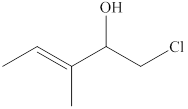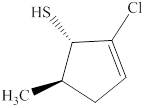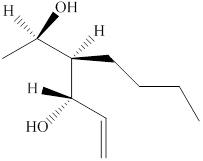
Concept explainers
(a)
Interpretation:
The substitutive name for the given compound is to be stated.
Concept introduction:
The systematic naming of organic compound is given by IUPAC. The naming of organic compound is done in such a way that the structure of organic compound is correctly interpreted from the name.
The hydrocarbons that are attached to the longest chain are called substituents and they are written as prefix in alphabetical order.
Answer to Problem 8.5P
The substitutive name for the given compound is
Explanation of Solution
The given compound is
The substitutive name for the given compound is
(b)
Interpretation:
The substitutive name for the given compound is to be stated.
Concept introduction:
The systematic naming of organic compound is given by IUPAC. The naming of organic compound is done in such a way that the structure of organic compound is correctly interpreted from the name.
The hydrocarbons that are attached to the longest chain are called substituents and they are written as prefix in alphabetical order.
Answer to Problem 8.5P
The substitutive name for the given compound is
Explanation of Solution
The given compound is
The substitutive name for the given compound is
(c)
Interpretation:
The substitutive name for the given compound is to be stated.
Concept introduction:
The systematic naming of organic compound is given by IUPAC. The naming of organic compound is done in such a way that the structure of organic compound is correctly interpreted from the name.
The hydrocarbons that are attached to the longest chain are called substituents and they are written as prefix in alphabetical order.
Answer to Problem 8.5P
The substitutive name for the given compound is
Explanation of Solution
The given compound is shown below.

Figure 1
The given compound has a longest chain of five carbon atoms with a double bond on third carbon atom. It is an
The use of prefix
The substitutive name for the given compound is
(d)
Interpretation:
The substitutive name for the given compound is to be stated.
Concept introduction:
The systematic naming of organic compound is given by IUPAC. The naming of organic compound is done in such a way that the structure of organic compound is correctly interpreted from the name.
The hydrocarbons that are attached to the longest chain are called substituents and they are written as prefix in alphabetical order.
Answer to Problem 8.5P
The substitutive name for the given compound is
Explanation of Solution
The given compound is shown below.

Figure 2
The given compound has a cyclic ring of five carbon atoms with a double bond on second carbon atom. It is an alkene, the suffix used for an alkene is –ene. Therefore, the parent name is
The naming of chiral center and geometric isomers are based on Cahn-Ingold-Prelog priority rules. If the priority assigned to each group attached to the chirality center in a molecule is in a clockwise direction, then it is the R-stereoisomer, and if this is counter-clockwise, then it is the S-stereoisomer. R and S-stereoisomer are mirror images of each other. Therefore, the name of this compound is
The substitutive name for the given compound is
(e)
Interpretation:
The substitutive name for the given compound is to be stated.
Concept introduction:
The systematic naming of organic compound is given by IUPAC. The naming of organic compound is done in such a way that the structure of organic compound is correctly interpreted from the name.
The hydrocarbons that are attached to the longest chain are called substituents and they are written as prefix in alphabetical order.
Answer to Problem 8.5P
The substitutive name for the given compound is
Explanation of Solution
The given compound is shown below.

Figure 3
The given compound has a chain of six carbon atoms with a double bond on fifth carbon atom. It is an alkene, the suffix used for an alkene is –ene. Therefore, the parent name is
The naming of chiral center and geometric isomers are based on Cahn-Ingold-Prelog priority rules. If the priority assigned to each group attached to the chirality center in a molecule is in a clockwise direction, then it is the R-stereoisomer, and if this is counter-clockwise, then it is the S-stereoisomer. R and S-stereoisomer are mirror images of each other. Therefore, the name of this compound is
The substitutive name for the given compound is
(f)
Interpretation:
The substitutive name for the given compound is to be stated.
Concept introduction:
The systematic naming of organic compound is given by IUPAC. The naming of organic compound is done in such a way that the structure of organic compound is correctly interpreted from the name.
The hydrocarbons that are attached to the longest chain are called substituents and they are written as prefix in alphabetical order.
Answer to Problem 8.5P
The substitutive name for the given compound is
Explanation of Solution
The given compound is shown below.

Figure 4
It consists of a cyclic ring of six carbon atoms. Therefore, the parent name is cyclohexa. There are two double bonds present at the second and fifth carbon atom of the ring. Also, one hydroxyl group is attached at the first carbon atom. Therefore, the name of this compound is
The substitutive name for the given compound is
(g)
Interpretation:
The substitutive name for the given compound is to be stated.
Concept introduction:
The systematic naming of organic compound is given by IUPAC. The naming of organic compound is done in such a way that the structure of organic compound is correctly interpreted from the name.
The hydrocarbons that are attached to the longest chain are called substituents and they are written as prefix in alphabetical order.
Answer to Problem 8.5P
The substitutive name for the given compound is
Explanation of Solution
The given compound is shown below.

Figure 5
It consists of a chain of five carbon atoms with hydroxyl group attached at the second carbon atom. The alcohols contain hydroxyl
The substitutive name for the given compound is
(h)
Interpretation:
The substitutive name for the given compound is to be stated.
Concept introduction:
The systematic naming of organic compound is given by IUPAC. The naming of organic compound is done in such a way that the structure of organic compound is correctly interpreted from the name.
The hydrocarbons that are attached to the longest chain are called substituents and they are written as prefix in alphabetical order.
Answer to Problem 8.5P
The substitutive name for the given compound is
Explanation of Solution
The given compound is shown below.

Figure 6
It consists of a chain of three carbon atoms with thiol group attached at the second carbon atom. One methyl group is attached at the second carbon atom. Therefore, the name of this compound is
The substitutive name for the given compound is
Want to see more full solutions like this?
Chapter 8 Solutions
Organic Chemistry Study Guide and Solutions
- please provide the structure for this problem, thank youarrow_forwardpresented by Morallen Lig Intermine the hand product for the given mution by adding atoms, bonds, nonhonding diarion panda скуль Step 3: Comp the draw the product Step 2: Agama workup Compithe 429 ملولةarrow_forwardReaction A 0,0arrow_forward
- presented by Morillon Leaning Predict the organic product for the min кусур HSC Adithane carved arnown to come than that to the condon slchroruis in acid in in aquishri with ноюarrow_forward6.15PM Sun Mar 30 K Draw the major product of this reaction. Include any relevant stereochemistry. Ignore inorganic byproducts. Problem 1 of O H [PhзPCH2CH3]*C|¯ NaH Drawing > Q Atoms, Bonds and Draw or tap a nearrow_forward8:17 PM Sun Mar 30 Draw the major product of this reaction. Ignore inorganic byproducts. HSCH2CH2CH2SH, BF3 Probler Drawing Ato Bonds Clarrow_forward
- Name the major organic product of the following action of 4-chloro-4-methyl-1-pentanol in neutral pollution 10+ Now the product. The product has a molecular formula f b. In a singly hain, the starting, material again converts into a secule with the molecular kormula CIO. but with comply Draw the major organic structure inhalationarrow_forwardMacmillan Learning Alcohols can be oxidized by chromic acid derivatives. One such reagent is pyridinium chlorochromate, (C,H,NH*)(CICTO3), commonly known as PCC. Draw the proposed (neutral) intermediate and the organic product in the oxidation of 1-butanol by PCC when carried out in an anhydrous solvent such as CH₂C₁₂. PCC Intermediate OH CH2Cl2 Draw the intermediate. Select Draw Templates More с H Cr о Product Draw the product. Erase Select Draw Templates More H о Erasearrow_forwardIf I have 1-bromopropene, to obtain compound A, I have to add NaOH and another compound. Indicate which compound that would be. A C6H5 CH3arrow_forward

 Chemistry: Principles and PracticeChemistryISBN:9780534420123Author:Daniel L. Reger, Scott R. Goode, David W. Ball, Edward MercerPublisher:Cengage Learning
Chemistry: Principles and PracticeChemistryISBN:9780534420123Author:Daniel L. Reger, Scott R. Goode, David W. Ball, Edward MercerPublisher:Cengage Learning Introductory Chemistry: An Active Learning Approa...ChemistryISBN:9781305079250Author:Mark S. Cracolice, Ed PetersPublisher:Cengage Learning
Introductory Chemistry: An Active Learning Approa...ChemistryISBN:9781305079250Author:Mark S. Cracolice, Ed PetersPublisher:Cengage Learning Chemistry: Principles and ReactionsChemistryISBN:9781305079373Author:William L. Masterton, Cecile N. HurleyPublisher:Cengage Learning
Chemistry: Principles and ReactionsChemistryISBN:9781305079373Author:William L. Masterton, Cecile N. HurleyPublisher:Cengage Learning



